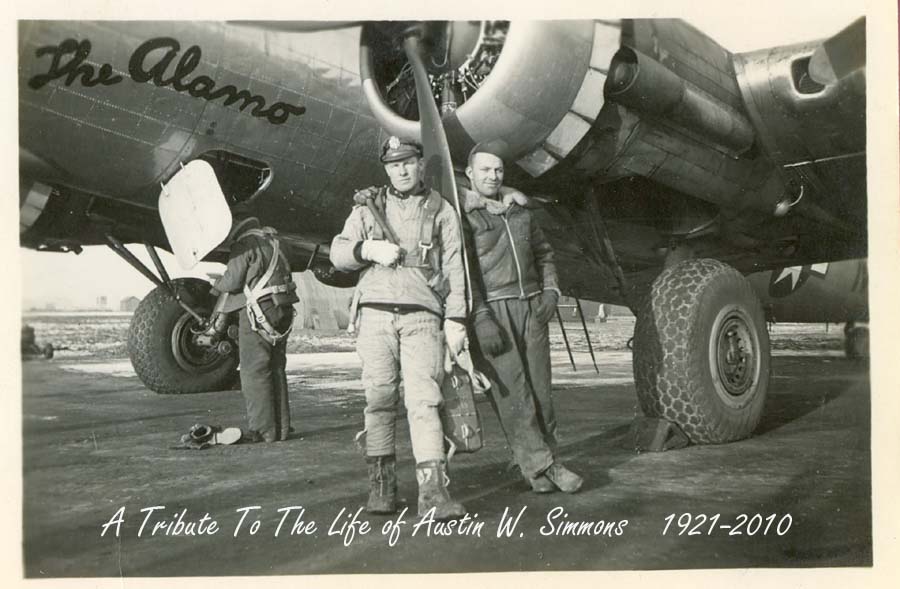Major Austin W. Simmons
A little over a decade after being called to Active Duty Cpt. Austin Simmons was promoted to Major effective April 19, 1955 despite a minor setback with the rejection of his application to become an officer in the Regular Army. A month later the promotion outlined in the April 19th letter was revoked. The reason was simply a clerical error for Cpt. Simmons was promoted to Major on July 31st, 1947 by order of the President of the United States.
It has to be noted here that Austin had only a high school education and unlike so many of those officers who stayed in the ranks had no formal schooling nor was a graduate of West Point. The advantage he had was a commission during war time in which he was able to capitalize on and use to better himself and his family. This is in no way demeaning by any means, as it is thought that promotions during war time carry more prestige, honor and are more deserved. It has been documented on many occasions and relayed by those who knew him personally that he was a very bright individual but lacked that piece of paper to back him up.
The promotion in rank in July 1947 would be his last until right before his retirement in 1963 when he was promoted to Lt. Colonel and then retired. From what his wife Mary told me this did bother him a bit so much so that it is well documented that he took a number of advanced military education courses throughout his lengthy career and received many diplomas within the military education system. If you take into consideration that he was given command of a strategically important radar base in Iceland right as Vietnam and the Cold War was acceleration I would dare to speculate that his superior officers saw in Austin an extremely intelligent and capable officer, yet had their hands tied when it came to promoting an individual without the backup of a college degree. Haven taken that into consideration I wonder what course his career would have taken him had he obtained a degree.
Despite being a Major and having already proven himself to be a skilled B-17 pilot during combat, Austin still pursued the life of a pilot and on June 24, 1955 he officially became rated as a Senior Pilot.
Two years later on April 3, 1957 he was appointed as an Instructor and a Test Pilot for the B-25 Mitchell while stationed at the 766th AC&WRON in Maine. The twin engine B-25 medium bomber was much smaller than the four engine B-17 that launched his career that became famous in 1942 during the Doolittle Raid on mainland Japan.
B-25 Mitchell
It is important to note and I will try and delve into this a bit further as more substantial documents surface to back this up, but while serving towards the end of the Korean War Major Simmons was again called upon to fly combat missions. This time it was in what he called 'kiddy cars', comparing the flight characteristics of the B-17 to his new weapon, the F-86 Sabre. Rather than lengthy bomb runs his target was the Russian MiG-15's against whom he would give chase until his fuel supply or national borders would force him to turn and call off the fight. When he spoke about this in 2004 he recalled that at the time the MiG pilots wanted nothing to do with the American Sabre's and would always turn and flee. He did get close enough to fire his weapons but was not credited with any kills. Apparently the Air Force lacked enough experienced pilots and were losing jets and pilots to rooky mistakes. Major Simmons flew each mission with two 'wingmen' who were there to watch and learn from the more experienced pilot. Often as he recalls they would land with a 'dead stick' meaning that they had run out of fuel and had to mountain hop their way back to base catching the airflows off the mountain ranges to keep their warbirds in flight.
F-86 Sabre's in formation over Korea, circa 1954.
Towards the end of his career he was still learning new aircraft and on July 1, 1961 he was designated as Aircraft Commander in R4D type aircraft. The R4D or Douglas C-47 Skytrain, commonly known as Dakota was used primarily as a military transport plane during WW2 and throughout the 1950's.
C-47
Military Education Courses:
Dec 9, 1949: Military Management, Great Falls AFB, Great Falls, MT (Note: Spelled his name ‘Auston’)
Mar 17, 1951: Electronics Officers Airborne Course, Keesler AFB, MS
Feb 23, 1954: Advanced Communications Electronics Officer Course, Keesler AFB, MS
July 1, 1954: Officers Leadership, Air Training Command, Mather AFB, California
March 1, 1957: Interceptor Controller, Air Training Command, Tyndall AFB, Florida
Sept 17, 1957: Military Affairs Course, Air University Extension Course Institute
Dec 6, 1957: Air Defense Command Controller Proficiency Training Course, 4750th Air Defense Group (WPNS), Yuma, AZ
Jan 24, 1958: SAGE Familiarization Course XX1616-3, SAGE Technical Training Sqdrn, 3380th Technical Training Grp, Waltham, MA
Mar 12, 1959: Command And Staff School Course No. 3, Extension Course Institute, USAF
June 10, 1960: Graduated Command And Staff College at Maxwell AFB, Alabama, Air University
June 19, 1961: Fund Prin Guided Missiles, Extension Course Institute, USAF
Jan 8, 1962: Government Contract Course #7801 at Gunter AFB, Alabama, Extension Course Institute, Air University.
June 15, 1962: ‘The Economics of National Security’ from the Industrial College Of The Armed Forces, scoring in the upper 25 percent of graduates.
And on June 10, 1960 Mary J. Simmons received a Distaff Diploma from the Air University ‘for having cooperated with Command and Staff College and withstanding the onslaught of Demanding Air Force Requirements, And In General Being A Major Influence In The Satisfactory Completion Of The Resident Course By Her Husband…’

No comments:
Post a Comment